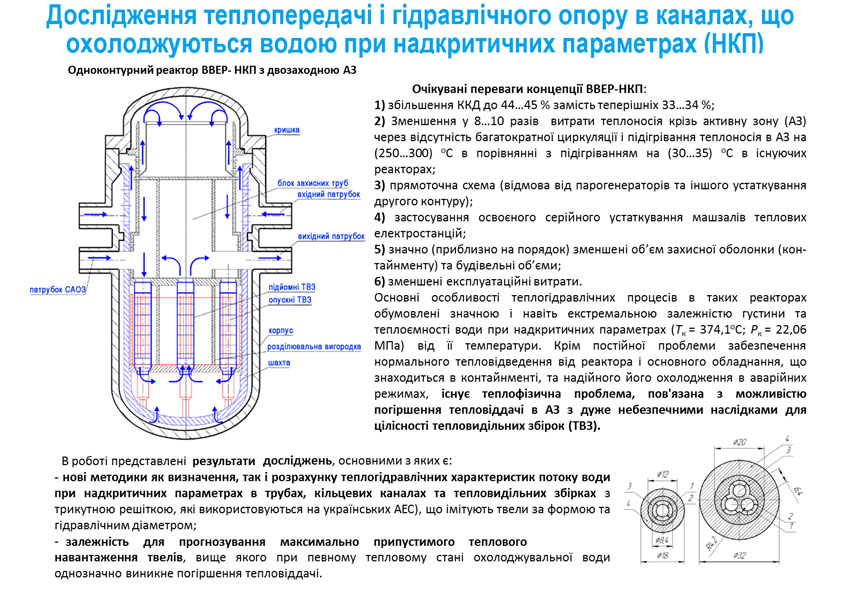Study of thermohydraulic processes in the elements of heat removal systems for advanced nuclear engineering facilities
The formulation and conduct of this work are due to: 1) unacceptable uncertainty of temperature regimes of fuel elements (fuel rods) of promising reactors in conditions close to the deteriorated heat transfer (DHT); 2) the practical impossibility of studying the temperature regimes of fuel assemblies in real conditions of nuclear reactors (NR); 3) strengthening the priority focus on passive methods of heat dissipation in nuclear energy technologies; 4) the need to increase the efficiency and reliability of promising passive heat dissipation systems of the evaporation- condensation type (ECT); 5) the need to improve the accuracy of determining and forecasting the limits of the modes of normal operation of these systems.
For the concept of NR with supercritical parameters (SCP) of the coolant is very important to predict the deterioration of heat transfer (DHT), as well as the impact of this phenomenon on the main characteristics of the promising active zone. There are two main problems related to methods for predicting the characteristics of DHT: the problem of applying implicit empirical dependencies and the problem of "complicating" statements in modeling using computational hydrodynamics (CFD). The main idea, which concerns CFD in the context of the work performed, is to, based on relatively simple and economical RANS models of turbulence, evaluate their capabilities in terms of adaptation to the conditions of nonlinear heat transfer in SCP. Three turbulence models were selected, including two two-parameter (RNG and SST) and one-parameter - EVT, which are validated (qualified) on the basis of complex probe studies of the structure of turbulent carbon dioxide flow taking into account the lifting force. The main purpose of this analysis was to assess the "sensitivity" of the transport equations of turbulent characteristics, as well as the possibility of universal near wall functions (UNWF). As a result of research, the selected models are qualified both in terms of their predictive properties and their possible adaptation for heat transfer problems with supercritical parameters. Based on experimental studies of KPI name Igor Sikorsky on the 3rd and 7th rod assemblies with SCP water developed the appropriate CFD models and evaluated their predictive properties in the conditions of DHT. The influence of quantitative and qualitative differences between calculations and experiment on the stress state of fuel rod simulators is analyzed. The adaptation of UNWF in the context of creation of special temperature wall function (SNWF) is offered. A transcendental dependence for estimating the wall temperature based on the distribution of the main flow characteristics in the near-wall region using high-Re turbulence models is obtained. The proposed temperature SNWF allows to obtain predicted temperature fields for DHT modes. An original procedure for solving a system of nonlinear differential and transcendental equations based on the known method of transfer matrices (TMM) is proposed. The advantages of thermohydraulic realization of TMM are demonstrated on the basis of implicit correlations. On the basis of the conducted CFD research the technique of the analysis of influence of DHT on a stressful condition of perspective assemblies is offered. Realized tools can be used in the design of promising active zones. In relation to heat transfer devices ECT as promising elements of passive heat dissipation systems and thermal protection in nuclear energy. Regularities of influence of initial structural parameters on specific structural characteristics, characteristics of hydraulic resistance, capillary pressure and capillary-filtration properties of effective porous metal fiber capillary structures (MFCS) for heat transfer devices of ECT as perspective elements of passive systems of heat dissipation and thermal protection in nuclear power are revealed. dependences to determine these characteristics and properties. As a result of research of the processes limiting heat transfer capacity of evaporating and condensing devices under conditions of capillary transport at one dimensional filtration of the intermediate heat carrier and at interaction of capillary and mass forces, regularitiesof influence of MFCS characteristics, thermophysical properties of heat carrier, geometrical parameters of the device marginal heat fluxes, and on this basis the dependences for determining the marginal heat fluxes, as well as the optimal structural parameters of the MFCKS in terms of providing extreme (maximum) values of marginal heat fluxes. To increase the accuracy of determining the capillary-transport limitation of heat transfer capacity, a two-dimensional model of filtration in the capillary structure of the heat transfer element (HE) of ECT is proposed. To increase the heat transfer capacity of HE ECT, a capillary-arterial system in three zones is proposed and implemented, as well as the creation of a capillary-arterial system in the evaporation zone, separate channels for steam and condensate in the transport zone and the organization of concomitant flow in the condensation zone. Technological processes of HE ECT creation with metal CS of fiber structure with the set characteristics are developed. Technological solutions for the creation of HE with changes in the parameters of the CS by capillary filtration directions were developed.Schematic and constructive solutions for reliable and effective passive evaporation-condensatio systems for heat dissipation in accidents with loss of coolant, which are protected by patents of Ukraine.

| Attachment | Size |
|---|---|
| 373.6 KB |




